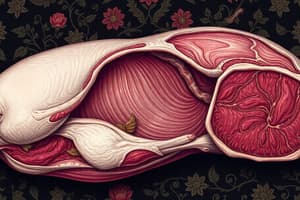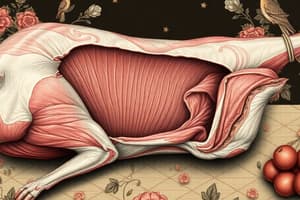Podcast
Questions and Answers
What is the role of homeostasis during the muscle-to-meat conversion?
What is the role of homeostasis during the muscle-to-meat conversion?
- It disrupts the biochemical reactions involved.
- It maintains the physiological balance in the muscles. (correct)
- It accelerates the conversion process.
- It sustains aerobic metabolic activity.
What initiates the sequence of postmortem changes in muscle?
What initiates the sequence of postmortem changes in muscle?
- Muscle contraction.
- Blood pressure elevation.
- Exsanguination. (correct)
- Nutrient absorption.
Why is thorough bleeding important in the slaughter process?
Why is thorough bleeding important in the slaughter process?
- To enhance meat color.
- To reduce the growth of spoilage organisms. (correct)
- To ensure better muscle contraction.
- To maintain flavor profiles.
Which factor is most crucial in determining meat quality after slaughter?
Which factor is most crucial in determining meat quality after slaughter?
What happens to aerobic metabolism after exsanguination?
What happens to aerobic metabolism after exsanguination?
What aspect of muscle contributes to its conversion to meat?
What aspect of muscle contributes to its conversion to meat?
How do sheep and goats differ from cattle during exsanguination?
How do sheep and goats differ from cattle during exsanguination?
What physiological change occurs in the muscle during exsanguination?
What physiological change occurs in the muscle during exsanguination?
What is the primary effect of lactic acid accumulation in muscle post-slaughter?
What is the primary effect of lactic acid accumulation in muscle post-slaughter?
Which enzyme is NOT involved in glycogen degradation?
Which enzyme is NOT involved in glycogen degradation?
What condition is characterized by a rapid decline in pH and low water-holding capacity in meat?
What condition is characterized by a rapid decline in pH and low water-holding capacity in meat?
What physiological mechanism can accelerate glycogenolysis in muscle?
What physiological mechanism can accelerate glycogenolysis in muscle?
What determines the ultimate pH of meat after exsanguination?
What determines the ultimate pH of meat after exsanguination?
Which of the following reflects a correct sequence of events during post-mortem muscle metabolism?
Which of the following reflects a correct sequence of events during post-mortem muscle metabolism?
How does a rapid pH decline impact muscle proteins?
How does a rapid pH decline impact muscle proteins?
What is the main result of high levels of stress in animals before slaughter?
What is the main result of high levels of stress in animals before slaughter?
What is the primary source of ATP in muscle cells prior to rigor mortis?
What is the primary source of ATP in muscle cells prior to rigor mortis?
What is a characteristic of DFD meat?
What is a characteristic of DFD meat?
What event triggers the release of cathepsins in muscle cells?
What event triggers the release of cathepsins in muscle cells?
How does rapid chilling affect meat toughness?
How does rapid chilling affect meat toughness?
What does cold shortening commonly affect?
What does cold shortening commonly affect?
What changes occur to muscle tissues post exsanguination?
What changes occur to muscle tissues post exsanguination?
What effect does rapid pH decline have on muscle energy stores?
What effect does rapid pH decline have on muscle energy stores?
What is the first line of defense against bacterial invasion in living animals?
What is the first line of defense against bacterial invasion in living animals?
What percentage of the non-protein nitrogen (NPN) in the extracts is accounted for by histidine?
What percentage of the non-protein nitrogen (NPN) in the extracts is accounted for by histidine?
What is the process that occurs when collagen is converted into gelatin during cooking?
What is the process that occurs when collagen is converted into gelatin during cooking?
Which of the following compounds is NOT involved in the transformation of color during cooking meat?
Which of the following compounds is NOT involved in the transformation of color during cooking meat?
How does heat affect the properties of denatured proteins during cooking?
How does heat affect the properties of denatured proteins during cooking?
What primarily contributes to weight change in meat during cooking?
What primarily contributes to weight change in meat during cooking?
Which of the following statements about fat cells during cooking is correct?
Which of the following statements about fat cells during cooking is correct?
What primarily influences the tenderness of meat?
What primarily influences the tenderness of meat?
What taste can be characterized in cooked meat?
What taste can be characterized in cooked meat?
How does connective tissue affect meat tenderness?
How does connective tissue affect meat tenderness?
What impact does cooking at higher temperatures have on collagen?
What impact does cooking at higher temperatures have on collagen?
What effect does aging have on meat after rigor mortis?
What effect does aging have on meat after rigor mortis?
Which factor contributes to the toughness of meat from older animals?
Which factor contributes to the toughness of meat from older animals?
What role does fat play in meat tenderness during cooking?
What role does fat play in meat tenderness during cooking?
What is the effect of temperature on the aging process of meat?
What is the effect of temperature on the aging process of meat?
Which amino acids are bound in form after beef has aged for two weeks?
Which amino acids are bound in form after beef has aged for two weeks?
What effect does fat marbling have on meat?
What effect does fat marbling have on meat?
Flashcards are hidden until you start studying
Study Notes
Muscle to Meat Conversion
- Muscle is the main component of meat and meat products.
- After an animal dies, its systems shut down causing changes in muscle.
- The conversion of muscle to meat is a gradual process.
- Homeostasis is the maintenance of a balanced internal state.
- The nervous system and endocrine glands control homeostasis.
Exsanguination
- Exsanguination is the first step in conventional animal slaughter.
- It involves removing as much blood as possible.
- Thorough bleeding is important to prevent spoilage and improve consumer appeal.
Circulatory Failure and Lactic Acid Accumulation
- Exsanguination stops oxygen delivery to muscle tissue.
- Aerobic metabolism stops, causing a shift to anaerobic glycolysis.
- Anaerobic glycolysis produces lactic acid, which accumulates in the muscle.
- Lactic acid accumulation lowers muscle pH.
Glycogenolysis
- After slaughter, muscle converts glycogen to lactic acid.
- Glycogen breakdown affects meat quality by changing pH.
- The enzymes glycogen phosphorylase and debranching enzyme break down glycogen.
- Stress before slaughter can deplete glycogen and influence pH.
pH Decline and Meat Quality
- The ultimate pH of meat depends on the glycogen level at slaughter.
- Lowering pH is crucial for meat conversion as it affects protein denaturation.
- High temperature and low pH denature proteins.
- Denaturation affects water-holding capacity, pigment intensity, and texture.
- Rapid pH decline leads to pale, soft, and exudative (PSE) meat.
- Slow pH decline leads to dark, firm, and dry (DFD) meat.
Rigor Mortis
- Rigor mortis is the stiffening of muscle after death.
- It occurs due to the depletion of ATP and the binding of actin and myosin.
- Muscle glycogen levels at slaughter influence rigor mortis onset.
- Rapid pH decline (PSE) accelerates rigor onset.
- High muscle temperature during rigor exacerbates protein denaturation.
Postmortem Changes in Muscle
- Muscle loses its protective barriers against microorganisms.
- Structural integrity of muscle is disrupted, affecting texture and tenderness.
- Proteolytic enzymes, called cathepsins, are released and degrade muscle proteins.
Cold Shortening
- Cold shortening occurs when carcasses are chilled rapidly before glycogen is depleted.
- Rapid cooling induces irreversible muscle contraction.
- Cold shortening makes meat tougher, particularly in lean beef and lamb.
Tenderness of Meat
- Meat tenderness is influenced by grain, connective tissue, and fat.
- Finer-grained meat is more tender.
- Collagen in connective tissue affects toughness.
- Fat content adds lubrication during cooking, improving tenderness.
Meat Ripening or Aging
- Meat becomes more tender, juicy, and flavorful over time.
- Ripening occurs faster at room temperature than in a refrigerator.
- Aging increases free amino acid nitrogen.
Changes in Cooking
- Cooking involves protein denaturation, collagen hydrolysis, color change, drip formation, flavor development, and nutrient loss.
- Cooking denatures proteins, altering their properties.
- Collagen breaks down into gelatin, increasing tenderness.
- Meat color changes due to oxidation of iron in heme molecules.
- Drip is the loss of water and other compounds during cooking.
- Cooking enhances flavor and aroma through the formation of volatile compounds.
Studying That Suits You
Use AI to generate personalized quizzes and flashcards to suit your learning preferences.




